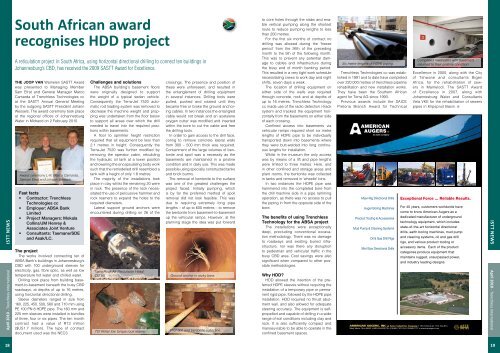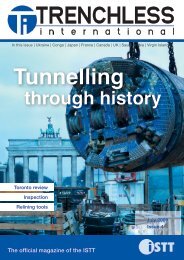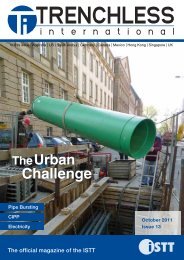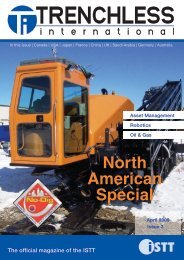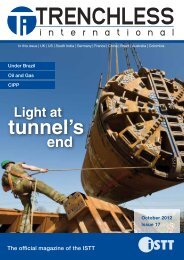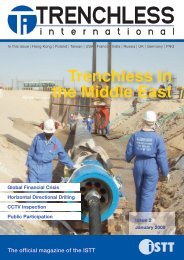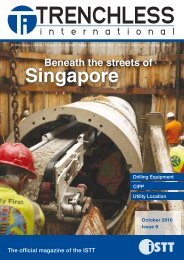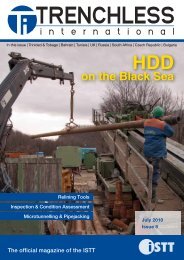Boring - Trenchless International
Boring - Trenchless International
Boring - Trenchless International
Create successful ePaper yourself
Turn your PDF publications into a flip-book with our unique Google optimized e-Paper software.
istt news<br />
April 2010 - <strong>Trenchless</strong> <strong>International</strong><br />
South African award<br />
recognises HDD project<br />
A reticulation project in South Africa, using horizontal directional drilling to connect ten buildings in<br />
Johannesburg’s CBD, has received the 2009 SASTT Award for Excellence.<br />
The Joop van Wamelen SASTT Award<br />
was presented to Managing Member<br />
Sam Efrat and General Manager Marco<br />
Camarda of <strong>Trenchless</strong> Technologies cc<br />
at the SASTT Annual General Meeting<br />
by the outgoing SASTT President Johann<br />
Wessels. The award ceremony took place<br />
at the regional offices of Johannesburg<br />
Water in Midrand on 2 February 2010.<br />
Award ceremony L-R, Marco Camarda,<br />
Samuel Efrat and Johann Wessels.<br />
Fast facts<br />
• Contractor: <strong>Trenchless</strong><br />
Technologies cc<br />
• Employer: ABSA Bank<br />
Limited<br />
• Project Managers: Mokala<br />
Collins/JM Henrey &<br />
Associates Joint Venture<br />
• Consultants: Taemane/SDE<br />
and Asak/LC.<br />
The project<br />
The works involved connecting ten of<br />
ABSA Bank’s buildings in Johannesburg’s<br />
CBD with 100 underground sleeves for<br />
electricity, gas, fibre optic, as well as low<br />
temperature hot water and chilled water.<br />
Drilling took place from building basement-to-basement<br />
beneath the busy CBD<br />
roadways, at depths of up to 16 metres,<br />
using horizontal directional drilling.<br />
Sleeve diameters ranged in size from<br />
160, 225, 450, 500, 560 and 710 mm using<br />
PE 100 PN 8 HDPE pipe. The 160 mm and<br />
225 mm sleeves were installed in bundles<br />
of three, four or six pipes. The ten month<br />
contract had a value of R13 million<br />
($US1.7 million). The type of contract<br />
document used was the NEC3.<br />
Challenges and solutions<br />
The ABSA building’s basement floors<br />
were originally designed to support<br />
the weight of a typical sedan vehicle.<br />
Consequently the Terra-Jet 7520 automatic<br />
rod loading system was removed to<br />
decrease the machine weight and propping<br />
was undertaken from the floor below<br />
to support all areas over which the drill<br />
needed to travel into the required positions<br />
within basements.<br />
A floor to sprinkler height restriction<br />
required that all equipment be less than<br />
2.1 metres in height. Consequently the<br />
Terra-Jet 7520 was further modified by<br />
removing the operator cabin, rebuilding<br />
the hydraulic oil tank at a lower position<br />
and lowering the encapsulating body work<br />
such that the remodelled drill resembled a<br />
tank with a height of only 1.8 metres.<br />
The majority of the installations took<br />
place in clay whilst the remaining 20 were<br />
in rock. The presence of the rock necessitated<br />
the use of percussive hammer and<br />
rock reamers to expand the holes to the<br />
required diameters.<br />
Lateral support ground anchors were<br />
encountered during drilling on 26 of the<br />
Terra-Rock Air Percussion Head<br />
OD 95.<br />
TCI Roller low torque rock reamer.<br />
crossings. The presence and position of<br />
these were unforeseen, and resulted in<br />
the entanglement of drilling equipment<br />
in several instances. Drilling tools were<br />
pulled, pushed and rotated until they<br />
became free or broke the ground anchoring<br />
cables. In two instances the entangled<br />
cable would not break and an acetylene<br />
oxygen cutter was modified and inserted<br />
within the bore to cut the cable and free<br />
the drilling tools.<br />
In order to gain access to the drill face,<br />
coring to remove concrete lateral walls<br />
from 300 – 500 mm thick was required.<br />
Containment of the large volumes of bentonite<br />
and spoil was a necessity as the<br />
basements are maintained in a pristine<br />
condition and in daily use. This was made<br />
possible using specially constructed tanks<br />
and brick burms.<br />
The removal of bentonite to the surface<br />
was one of the greatest challenges the<br />
project faced. Initially pumping, which<br />
is by far the preferred method of spoil<br />
removal did not look feasible. This was<br />
due to requiring extremely long pipe<br />
lengths – of up to 600 metres – to remove<br />
the bentonite from basement-to-basement<br />
up the vehicular ramps. However, at the<br />
planning stage the idea was put forward<br />
Ground anchor in rocky bore.<br />
Pilot drill and bentonite collection.<br />
to core holes through the slabs and enable<br />
vertical pumping along the shortest<br />
route to reduce pumping lengths to less<br />
than 200 metres.<br />
For the first six months of contract no<br />
drilling was allowed during the ‘freeze<br />
period’ from the 26th of the preceding<br />
month to the 5th of the following month.<br />
This was to prevent any potential damage<br />
to cables and infrastructure during<br />
the busy end of month banking period.<br />
This resulted in a very tight work schedule<br />
necessitating crews to work day and night<br />
shifts, seven days a week.<br />
The location of drilling equipment on<br />
either side of the walls was required<br />
through concrete, rock and at depths of<br />
up to 16 metres. <strong>Trenchless</strong> Technology<br />
cc made use of the radio detection i-track<br />
system and tracked the equipment horizontally<br />
from the basements on either side<br />
of each crossing.<br />
Confined access into basements via<br />
vehicular ramps required short six metre<br />
lengths of HDPE pipe to be individually<br />
transported down into basements where<br />
they were butt-welded into long continuous<br />
lengths for installation.<br />
Whilst in the museum the only access<br />
was by means of a lift and pipe lengths<br />
were limited to three metres. Here, and<br />
in other confined and storage areas and<br />
plant rooms, the bentonite was collected<br />
in tanks and removed in ‘wheelie’ bins.<br />
In two instances the HDPE pipe was<br />
hammered into the completed bore from<br />
the drill machine side in a pipe ramming<br />
operation, as there was no access to pull<br />
the piping in from the opposite side of the<br />
bore.<br />
The benefits of using <strong>Trenchless</strong><br />
Technology for the ABSA project<br />
The installations were exceptionally<br />
deep, precluding conventional excavation<br />
methodology. There was no damage<br />
to roadways and existing buried infrastructure,<br />
nor was there any disruption<br />
to pedestrian and vehicular traffic in the<br />
busy CBD area. Cost savings were also<br />
significant when compared to other possible<br />
methodologies.<br />
Why HDD?<br />
HDD allowed the insertion of the preferred<br />
HDPE sleeves without requiring the<br />
installation of a temporary pipe or permanent<br />
rigid pipe, followed by the HDPE pipe<br />
installation. HDD required no thrust abutment<br />
wall, and also allowed for adequate<br />
steering accuracy. The equipment is selfpropelled<br />
and capable of drilling in a wide<br />
range of soil conditions including clay and<br />
rock. It is also sufficiently compact and<br />
manoeuvrable to be able to operate in the<br />
confined basement spaces.<br />
Six metre lengths of HDPE piping.<br />
<strong>Trenchless</strong> Technologies cc was established<br />
in 1991 and to date have completed<br />
over 220,000 metres of trenchless pipeline<br />
rehabilitation and new installation works.<br />
They have been the Southern African<br />
agent for Terra AG since 1993.<br />
Previous awards include the SAICE<br />
Pretoria Branch Award for Technical<br />
Maxi-Rig Directional Drills<br />
Auger <strong>Boring</strong> Machines<br />
Product Tooling & Accessories<br />
Mud Pump & Cleaning Systems<br />
Oil & Gas Drill Rigs<br />
Mid-Size Directional Drills<br />
Completed installation with basement<br />
returned to their pristine condition.<br />
Excellence in 2000, along with the City<br />
of Tshwane and consultants Bigen<br />
Africa, for the rehabilitation of sewers<br />
in Mamelodi. The SASTT Award<br />
of Excellence in 2007, along with<br />
Johannesburg Water and Consultants<br />
Vela VKE for the rehabilitation of sewers<br />
pipes in Klipspruit Basin.<br />
Exceptional Force … Reliable Results.<br />
For 40 years, customers worldwide have<br />
come to know American Augers as a<br />
dedicated manufacturer of underground<br />
technology equipment, which includes<br />
state-of-the-art horizontal directional<br />
drills, earth boring machines, mud pump<br />
and cleaning systems, oil and gas drill<br />
rigs, and various product tooling or<br />
accessory items. Each of the product<br />
categories produce equipment that<br />
maintains rugged, unsurpassed power,<br />
and industry leading designs.<br />
istt news<br />
April 2010 - <strong>Trenchless</strong> <strong>International</strong><br />
18<br />
AA Company island Ad TI.indd 1<br />
12/14/09 4:57 PM<br />
19


